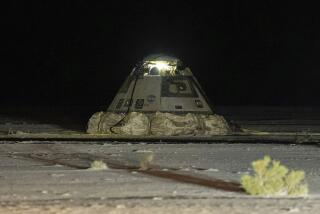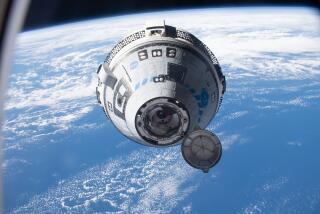Shuttle Tragedy’s Lesson Still Fresh 5 Years Later : NASA: Challenger explosion showed the space agency was ignoring problems. Some have been remedied, but experts place odds of losing another craft at 1 in 100.
- Share via
CAPE CANAVERAL, Fla. — The shock and the anguish from America’s worst space disaster are gone. The wounds, NASA says, have more or less healed.
But the sickening, heart-rending sight of the shuttle Challenger disintegrating 8.9 miles above the Atlantic Ocean five years ago Monday remains fresh in the minds of many as the space agency struggles toward an uncertain future.
“They’re still betting the organization every time they launch,” said John Logsdon, director of the Space Policy Institute at George Washington University.
Experts inside and outside NASA agree that another disaster this year or next could cripple if not crush the nation’s manned space program.
Last year’s trouble--the discovery of the Hubble Space Telescope’s flawed mirror, the grounding of a leaky shuttle fleet, the threatened collapse of the space station project--leaves little room for bungling, much less catastrophe.
Citing the “very real possibility of losing another orbiter in the near future,” the Bush Administration’s space advisory committee recommended in December that NASA reduce its dependence on the shuttle. Instead of building another spaceship, the panel suggested that NASA develop an unmanned, heavy-lift booster to be used for all missions except those requiring astronauts.
Some risk analysts put the odds of disaster at 1 in 100 shuttle flights. Others say it is more like several in 100. No one knows for sure.
“If the case is made that we’re going to be confronted with a Challenger accident every five or six years, I don’t think people have the stomach for that. I know I’m sure not eager to go through that again,” said John Pike, head of the Federation of American Scientists’ space policy project.
“When’s it going to blow up again? I think that’s the big question mark and issue right now.”
Intensifying the horror of the Challenger explosion for many was the loss of teacher Christa McAuliffe of Concord, N. H., the first ordinary American in space, who wistfully viewed her opportunity as “the ultimate field trip.”
For many at NASA, it seems like only yesterday that the shuttle exploded 73 seconds after liftoff, killing McAuliffe and the six other astronauts aboard and halting manned space flight for 2 1/2 years.
The date was Jan. 28, 1986. The time was 8:39 PST.
“The accident is something that I can’t forget nor do I want to,” said shuttle director Robert Crippen. “It is something we need to be sensitive to in the way we conduct business to be sure we continue to stress safety, which I believe we are doing.”
“That’s a day that’s part of you and always will be,” said Jay Greene, deputy manager of the shuttle program at Johnson Space Center in Houston.
Crippen was preparing to command an upcoming military mission when the accident occurred. He piloted the first shuttle flight 10 years ago this April, an anniversary he much prefers to focus on.
Since Columbia’s historic liftoff on April 12, 1981, with Crippen, then a rookie astronaut, and seasoned astronaut John Young, “We’ve done some very positive things that could not be done again with any other kind of machine,” Crippen said.
“See, I’m prejudiced, but I think we haven’t touched the surface of investigating the capabilities of the shuttle,” said Young, who still is an astronaut.
Greene was the ascent flight director at Mission Control for Challenger’s 10th and final journey, a satellite-delivery mission designated 51-L. He was a flight dynamics officer at the time of NASA’s only other large-scale tragedy, the Apollo spacecraft fire that killed three astronauts 24 years ago today.
For Greene, nothing--not the Jan. 27, 1967, launch pad fire nor the harrowing flight of Apollo 13 in 1970--compared to the Challenger accident and its torturous aftermath.
“The folks were all good friends. Real good friends,” Greene said softly, his voice trailing. “The vehicle was a good friend.”
Greene paused, then continued: “We don’t talk about it anymore. We did a lot after it happened over a lot of booze and over a lot of fights. We got really wrapped up in it. Maybe we mourned right and that’s part of why we don’t dwell on it now.”
A 13-member commission appointed by President Reagan determined that the accident was caused by a leak in a joint on Challenger’s right solid rocket booster. The panel also learned that trouble with the booster rocket joints dated back eight years and that management and communication problems contributed to the disaster, as well as an overambitious flight schedule.
Challenger was making the 25th shuttle flight that frigid, fateful morning. Thirteen more missions had been planned for 1986. The goal by 1990 was 24 a year, half the number initially envisioned by NASA.
“Whether it was a misperception or not, the agency had the notion that what the government, what the country wanted us to do was to fly the space shuttle a lot, as fast as we could fly it,” said Brewster Shaw, an astronaut-turned-administrator who now gives the final “go” for launch.
Thirteen missions have been logged since manned space flight resumed in September, 1988, with revamped shuttles and new safety rules.
There now are so many safeguards on shuttle flights that NASA is considering eliminating some of the double-checking and triple-checking of itemsR. Thompson, NASA’s deputy administrator, estimates that would reduce shuttle operating costs by as much as 25%; each flight costs $200 million to $250 million.
There would have been as many as three more flights if dangerous hydrogen leaks had not disabled two of NASA’s three shuttles last year.
Last year also saw a rash of accidents involving shuttle equipment, the most notable example a metal beam that was left to bang around inside Atlantis in October.
Although fewer shuttle-processing mishaps occurred during the fiscal year ending Sept. 30--26 compared to 42 the previous year--more money was lost. Nearly $4 million worth of equipment was damaged in fiscal year 1990, NASA statistics show. The year before, damage amounted to less than $831,000.
The department that keeps that tally--the Office of Safety and Mission Quality--was established five months after the Challenger accident. Since then, its work force has more than tripled to 7,598.
“Challenger showed we weren’t facing up to some of our problems, and we have reacted to that,” said George Rodney, who heads the safety office. “Are we totally successful? No. We have much more room to improve.”
Having a realistic flight schedule helps.
Seven shuttle flights are planned this year, the first one in late February or early March. Eight are scheduled for 1992, including the first flight of Challenger’s $2.1-billion replacement, the shuttle Endeavour. The flight rate would be higher if Columbia were not being taken out of the lineup this summer for nearly half a year for modifications that will extend its stays in space.
Twelve flights are planned for 1993. That is NASA’s annual goal for a four-ship fleet for the rest of the decade and beyond.
In accordance with the recommendations of the Advisory Committee on the Future of the U.S. Space Program, NASA is forming a task force with the Defense Department to assess the development of a heavy-lift launcher. In the meantime, the space agency is scrutinizing the shuttle manifest to see if any more cargoes can be shifted to unmanned rockets.
NASA Administrator Richard H. Truly said restructuring of the space station will extend a month beyond the early February deadline set by Congress so that the committee’s suggestions can be incorporated. Both Congress and the committee want a simpler, more efficient station than the one designed by NASA.
The station’s design has been refined and revised continuously since President Reagan announced the program with great fanfare in 1984. The permanently manned station, to be named Freedom, is to serve as an orbiting scientific laboratory. Japan and the European Space Agency have signed on for their own compartments.
Many NASA officials and astronauts privately acknowledge that the space agency should have begun developing a heavy-lift rocket long ago and planned a more practical space station. Nevertheless, they stand behind the shuttle, the station and the need for humans in space, despite the inevitable risk and the danger of slipping back into a pre-Challenger mentality.
Remembering helps.
On Monday, at precisely 8:38 a.m. PST, the time of Challenger’s last liftoff, workers at Kennedy Space Center will halt whatever they are doing and observe 73 seconds of silence. Flags will be lowered to half-staff.
It is an annual rite.
Among those pausing this year to remember will be men erecting a massive memorial to the 14 U.S. astronauts killed in the line of duty, four of them in training-jet accidents. The not quite 5-year-old Astronauts Memorial Foundation funded the $6.2-million project through the sale of Challenger license plates in Florida.
More to Read
Sign up for Essential California
The most important California stories and recommendations in your inbox every morning.
You may occasionally receive promotional content from the Los Angeles Times.










